The Berman and Stieglitz Galleries, ground floor
Main Building

Lee Miller Untitled (Exploding Hand), c. 1930 © Lee Miller Archives, England 2008. All rights reserved. www.leemiller.co.uk.
One of the most original and ambitious photographic artists of the twentieth century, Lee Miller (1907–1977) performed with unique success on both sides of the camera. Chronicling the diverse periods of her career, this exhibition begins with Miller's days as a model in the late 1920s and early '30s, continuing through her studio photography years in Paris and New York, her travels in Egypt and Eastern Europe, her days as a war correspondent, and finally to the relative tranquility of the post-war years at home in England.
The marvelous that is hidden in the ordinary...
Available in A selection of more than 140 images, mainly vintage photographs, celebrate Miller's remarkable life and her art—and how each reflected and influenced the other. Organized by the Victoria and Albert Museum on the occasion of the 2007 centenary of her birth, the exhibition spans her extraordinary career as a photographer and is the first complete retrospective, exploring her transformation from artist's muse to ground-breaking artist. The exhibition features extensive loans from the Lee Miller Archives in East Sussex, England, directed by Miller's son Antony Penrose, among other sources. Ten photographs from the Museum's collection are included in the traveling exhibition. Additional selections from the collection are featured in the Philadelphia venue, as are two photographs by Miller on loan from the Museum of Modern Art and one work from a private collection in New York.

Lee Miller Self Portrait in Headband, 1932 © Lee Miller Archives, England 2008. All rights reserved. www.leemiller.co.uk
An internationally renowned beauty, Miller was born in Poughkeepsie, New York, and studied theater and lighting design at Vassar College before moving to Manhattan, where a chance encounter with publishing magnate Condé Nast opened up a career in modeling. She began posing for such photographers as Arnold Genthe and Edward Steichen and her image appeared in magazines including Vogue and Vanity Fair. With her cropped hair, luminous eyes, and fresh complexion, Miller's looks embodied the ideal of the modern twentieth-century woman. Ready for a new challenge, she traveled to Paris in 1929 where she boldly declared herself the new student of artist Man Ray, quickly becoming his apprentice, muse, and lover. The pair collaborated closely over the next few years, as Miller learned studio, darkroom, and finishing work, rediscovering with Man Ray the forgotten Sabbatier effect, a technique of solarization in which positive and negative tones reverse along the outline of a subject, creating a dreamlike, halo appearance. Man Ray promptly adopted his darkroom error as a surrealist ploy, using it to transform selected photographic subjects into glowing, radiant beings. Miller absorbed these darkroom lessons as well as the spirit of Surrealism and began using them to develop an independent career, producing elegant abstract images and fashion photography.

Lee Miller Nude Bent Forward, c. 1930 © Lee Miller Archives, England 2008. All rights reserved. www.leemiller.co.uk.
A lively as well as lovely addition to the Paris art scene, Miller established friendships with the leading figures in the surrealist movement such as Salvador Dali, Max Ernst, and Meret Oppenheim, who further influenced her approach to photography. They shared a disdain for the literal meanings given to objects and focused on the undertones and poetic undercurrents they saw all around them, embracing the element of surprise, unexpected juxtaposition and a sense of the world made strange and new. Miller's work was published in French surrealist magazines, and she played a star role in artist Jean Cocteau's poetic and dreamlike film Blood of a Poet (1931), which required the arduous, hours-long effort of keeping her eyes closed and her arms strapped to her sides during shooting. Miller also took inspiration from the documentary street scenes of Eugène Atget, whose dream-like photographs captured Paris and its mysteries, both ancient and modern. Miller's work from this period combines the scepticism of the post-World War I surrealists with a sense of new creative opportunities, emphasizing the formlessness and mystery of ordinary objects, removed from their specific context. A favorite focus of Miller's was the human hand, which she made frequent use of in her images—gesturing in silhouette from a balcony, or arranging a set of curls at the back of a woman's head.

Lee Miller Portrait of Space, 1937 © Lee Miller Archives, England 2008. All rights reserved. www.leemiller.co.uk.
The fruitful but turbulent relationship between Miller and Man Ray ended badly in autumn 1932. Miller relocated to New York where she set up a portrait studio with her younger brother Erik. Using contacts from her years as a model as well as her Paris connections, she established a client list that included advertising agencies, fashion and cosmetics companies, and portrait commissions for the theater. In winter 1933 she enjoyed her first solo exhibition (and only solo exhibition during her lifetime) of photographs at the Julien Levy Gallery, a show that included Paris street scenes, architectural studies and still life, and portraits of figures such as Claire Luce, Gene Tunney, and Man Ray. The show received positive reviews in the New York Times, and the New York Post praised the invigorating effect of her use of "camera plus brains." A number of photographs owned by Levy, now in the Museum's collection, are included in this exhibition. In 1934 Miller married Aziz Eloui Bey, a prominent Egyptian businessman, and went to live with him in Cairo. She undertook extended trips into the desert and was inspired to make some of her best-known photographs, including the stark, dramatic Portrait of Space (1937). The marriage, and Miller's time in Egypt, did not last. In 1937 she met the British surrealist painter Roland Penrose, who would become her second husband (and, years later, a founder of London's Institute of Contemporary Arts). The pair traveled and worked in Eastern Europe, and settled in north London in 1939. Miller worked frequently for British Vogue, where she published a diverse range of images and subjects, including the Second World War.

Lee Miller Dead SS Guard in the Canal, 1945 © Lee Miller Archives, England 2008. All rights reserved. www.leemiller.co.uk.
In 1942 Miller became one of a handful of accredited female war correspondents, and the only woman photojournalist active in combat areas. She photographed medical teams working frantically to save the wounded shortly after the D-Day invasion, and the liberation of Paris in 1945 for the pages of British Vogue. As the war came to its conclusion, Miller traveled east to Luxembourg, Belgium and into Germany where she published shocking first-hand accounts of the concentration camp at Dachau, and disturbing images of Hitler's abandoned flat in Munich. The images Miller captured in war's immediate aftermath reflected a disturbing, surrealistic juxtaposition of horror and banality, including her photograph of a dead SS officer submerged in the shallow waters of a canal; the personal effects found on the desktop in Hitler's Munich apartment; or the pale face of an infant dying of starvation in Vienna, its face framed by crisp white blankets. These images and her wartime experiences affected Miller profoundly and continued to her haunt her until the end of her life. In the postwar years Miller continued to work for British Vogue, whose highly talented staff included Cecil Beaton, Norman Parkinson, and Irving Penn contributing from New York. Miller herself seemed to grow disenchanted with the world of fashion photography, perhaps exhausted by her prolific output during the war. In September 1947 she gave birth to a son, Antony, and in 1949 she moved with her husband Roland Penrose to Farley Farm in Sussex. Here she embraced her newfound domesticity with the same imaginative zeal and surrealistic sense of humor that had marked earlier phases of her life, entertaining a stream of art-world friends and colleagues. Her final photographic contribution to British Vogue was the photo essay Working Guests, published in 1953, in which she describes efforts to put her well-known houseguests to work at various tasks around the farm—among them Max Ernst, Saul Steinberg, and Richard Hamilton.
This exhibition is organized by the Victoria and Albert Museum, London
Katherine Ware • Curator of Photographs
Julia Dolan • Horace W. Goldsmith Curatorial Fellow in Photography
Victoria & Albert Museum, London (September 15, 2007–January 6, 2008)
Philadelphia Museum of Art (January 26–April 27, 2008)
San Francisco Museum of Modern Art (July 1–September 21, 2008 )
Galerie nationale du Jeu de Paume, Paris (October 14, 2008–January 11, 2009)
The Berman and Stieglitz Galleries, ground floor
Main Building
Exhibitions in the Berman and Stieglitz Galleries in 2008, including The Art of Lee Miller, are made possible by RBC Wealth Management.
Mark Haworth-Booth • The University of the Arts London